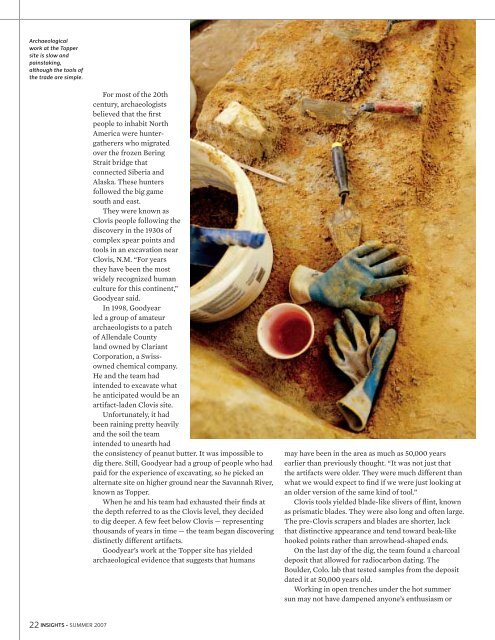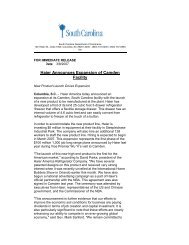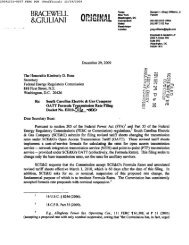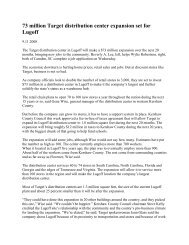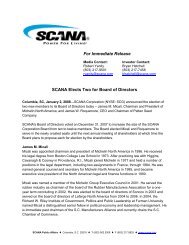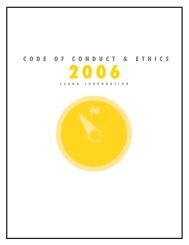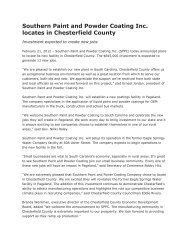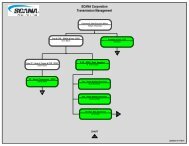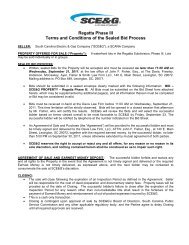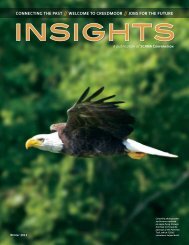Summer 2007 - SCANA Corporation
Summer 2007 - SCANA Corporation
Summer 2007 - SCANA Corporation
Create successful ePaper yourself
Turn your PDF publications into a flip-book with our unique Google optimized e-Paper software.
Archaeological<br />
work at the Topper<br />
site is slow and<br />
painstaking,<br />
although the tools of<br />
the trade are simple.<br />
For most of the 20th<br />
century, archaeologists<br />
believed that the first<br />
people to inhabit North<br />
America were huntergatherers<br />
who migrated<br />
over the frozen Bering<br />
Strait bridge that<br />
connected Siberia and<br />
Alaska. These hunters<br />
followed the big game<br />
south and east.<br />
They were known as<br />
Clovis people following the<br />
discovery in the 1930s of<br />
complex spear points and<br />
tools in an excavation near<br />
Clovis, N.M. “For years<br />
they have been the most<br />
widely recognized human<br />
culture for this continent,”<br />
Goodyear said.<br />
In 1998, Goodyear<br />
led a group of amateur<br />
archaeologists to a patch<br />
of Allendale County<br />
land owned by Clariant<br />
<strong>Corporation</strong>, a Swissowned<br />
chemical company.<br />
He and the team had<br />
intended to excavate what<br />
he anticipated would be an<br />
artifact-laden Clovis site.<br />
Unfortunately, it had<br />
been raining pretty heavily<br />
and the soil the team<br />
intended to unearth had<br />
the consistency of peanut butter. It was impossible to<br />
dig there. Still, Goodyear had a group of people who had<br />
paid for the experience of excavating, so he picked an<br />
alternate site on higher ground near the Savannah River,<br />
known as Topper.<br />
When he and his team had exhausted their finds at<br />
the depth referred to as the Clovis level, they decided<br />
to dig deeper. A few feet below Clovis — representing<br />
thousands of years in time — the team began discovering<br />
distinctly different artifacts.<br />
Goodyear’s work at the Topper site has yielded<br />
archaeological evidence that suggests that humans<br />
may have been in the area as much as 50,000 years<br />
earlier than previously thought. “It was not just that<br />
the artifacts were older. They were much different than<br />
what we would expect to find if we were just looking at<br />
an older version of the same kind of tool.”<br />
Clovis tools yielded blade-like slivers of flint, known<br />
as prismatic blades. They were also long and often large.<br />
The pre-Clovis scrapers and blades are shorter, lack<br />
that distinctive appearance and tend toward beak-like<br />
hooked points rather than arrowhead-shaped ends.<br />
On the last day of the dig, the team found a charcoal<br />
deposit that allowed for radiocarbon dating. The<br />
Boulder, Colo. lab that tested samples from the deposit<br />
dated it at 50,000 years old.<br />
Working in open trenches under the hot summer<br />
sun may not have dampened anyone’s enthusiasm or<br />
22 INSIGHTS • SUMMER <strong>2007</strong>


